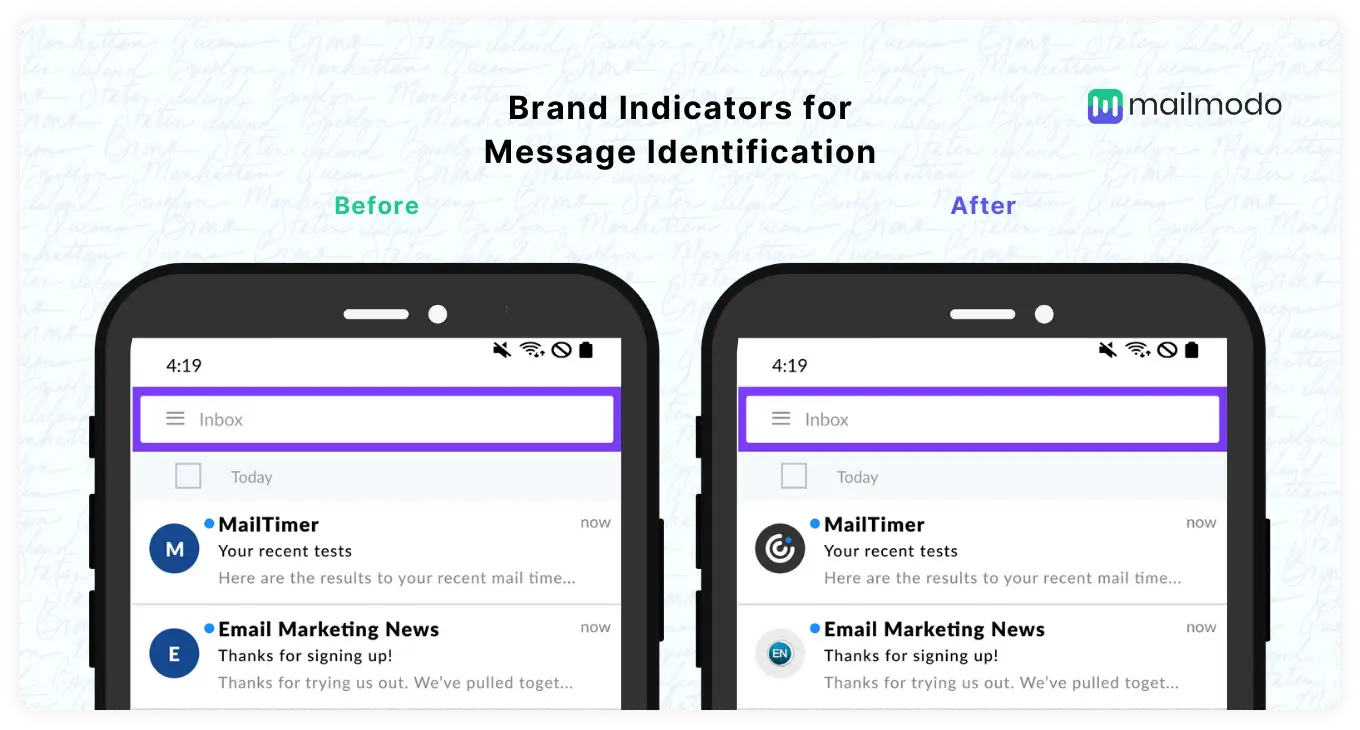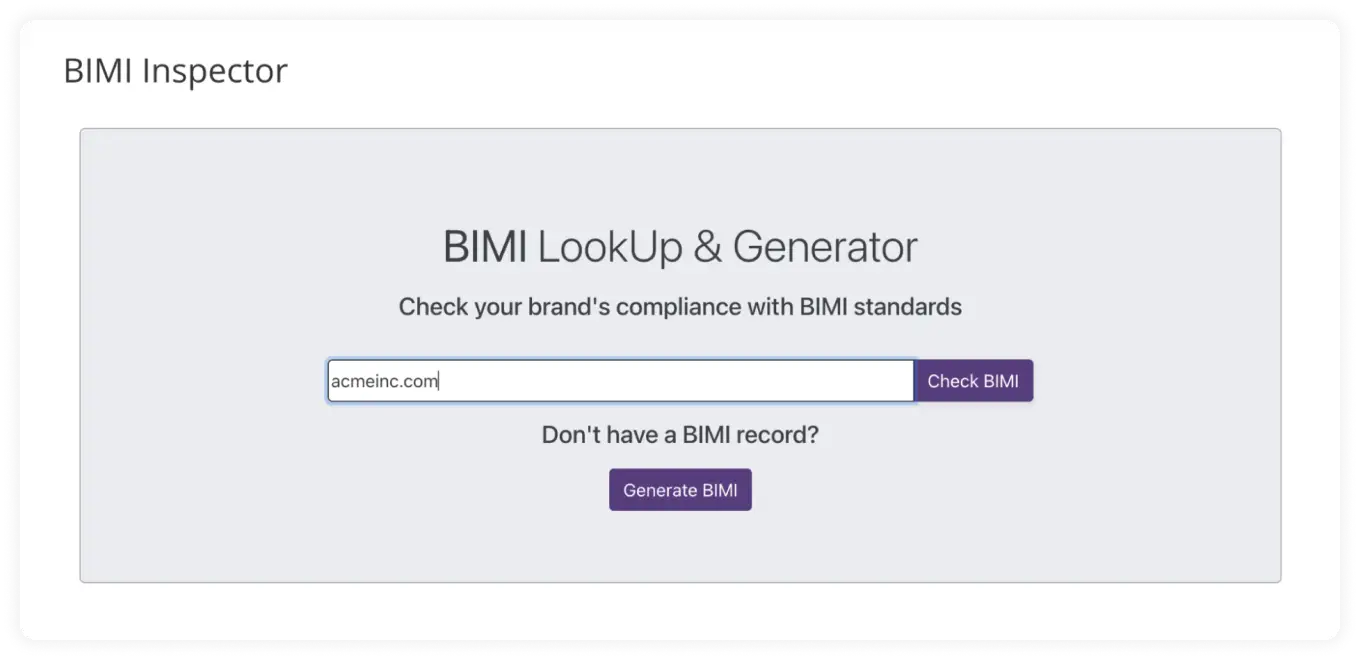Won’t it be amazing to have your brand logos next to the emails you send? Your customers can recognize you in their inboxes and open their emails with confidence. To address this, BIMI - a new feature that offers brand recall and added security is slowly paving its way from testing to adoption.
Let’s dive deeper to understand BIMI.
Table of contents
What is BIMI?
Brand Indicators for Message Identification (BIMI) is a standard that adds your brand logo to your email messages in supported inboxes. It’s a visual verification that helps your recipients recognize and trust the messages you send.
An example of BIMI 👇 in action

Not just that, it provides your brand the ability to stand out in inboxes over other emails.
How does BIMI work?
Similar to other authentication standards, BIMI is a text file that is of a specific format and resides in your sending servers (DNS records).
After your mail is sent, your receiver’s inbox provider finds your BIMI text using a DNS lookup. This BIMI text contains your organization’s logo. Once the provider finds your message they attach the BIMI logo to your message. This improves visibility and helps your recipient recognize it is a brand they trust.
Though the concept sounds simple, you need to learn a few things while setting up BIMI for your brand.
Why is it important for email marketers
BIMI is important for the following reasons:
1. Helps combat phishing
Most of the consumers who receive emails aren’t techies. They hardly know how to verify technical information like SPF, DKIM, or the return path which determines the legitimacy of the email.
When brands get impersonated, they’re most likely to lose business. In worst cases, maybe face legal liabilities which can erode consumer trust and repel the actual senders’ email messages.
When fraudsters keep spoofing your brands’ email domains in phishing attacks, your servers can get blacklisted, decreasing your email-based revenue streams. Therefore, it is important to have protocols like BIMI in place to inculcate trust.
Since BIMI is authenticated by a DMARC protocol, which stops billions of email impersonation attacks every year. The brand logo should be certified with MVA (Mark Verifying Authority), which provides evidence of verification of standards such as - size, trademark, and content.
Not only does BIMI protect the brand’s reputation, since the logo is verified by both the sender and recipient, but it cannot be faked as well.
2. Aids in brand recall
As per DMA report, in 2021, email campaign ROIs was 51.52 USD for every $1 spent as compared to 47.75 USD in 2020. Emails are still a primary marketing channel. Not just that, with inboxes more crowded than ever, grabbing the eyeballs of your recipients provides brand visibility.
When you use BIMI, your brand’s logo arrives next to your email, quickly catching the eye of your recipient. This means that your logo will be broadcasted to subscribers every time your email arrives.
Additionally, they’re more likely to open the email since they know it’s from a brand they trust and not just another phishing email.
This will help you create deeper connections with your recipients, improve brand awareness, and keep your company at the top of their inboxes and minds.
3. Increases open rates
The good news for marketers? The initial testing of BIMI proved to show an increase in email open rates by 10%. With the launch of BIMI marketers have an opportunity to display their brand logo in the preview panel, which might influence the recipient’s decision to open an email.
A combination of brand recognition, trust in your brand’s email can boost open, click-through, and conversion rates in your email marketing campaigns.
BIMI inculcates the trust in your recipient which in turn will fetch you increased open rates. In the end, it’s on your brand to provide value in your email campaigns.
Implementing BIMI for dummies
BIMI operates in conjunction with other email authentication technologies like SPF, DKIM, and DMARC as seen earlier. To execute BIMI you need to complete the following email authentication protocols:
Implement a Sender Policy Framework (SPF), which specifies IP addresses that are permitted to send emails for the domain.
Implement Domain Keys Identified Mail (DKIM), which adds a digital signature and verifies if the emails haven’t been changed during transit.
Implement DMARC, which is built on top of SPF/DKIM to tell the receiving server what to do if SPF/DKIM authentication fails.
After your authentication generate your logo in SVG (Scalable Vector Graphics) file format and upload it to the server.
A VMC (Verified Mark Certificate) validation process(applicable to non-Gmail participants only) involves rigorous identity and trademark verification. VMCs are usually used to encrypt communications between browsers and websites.
Next, you need to visit your domain name system (DNS) hosting provider and create a new record to Implement DNS records for BIMI.
Once all the above steps are completed, your logo will be evaluated and displayed in the recipients’ inbox.
If you want to check your brand’s compliance with BIMI standards, you can check out the BIMI Inspector
Once you type out your domain name you can learn what has been implemented and what needs to be. You can find the BIMI Inspector at the BIMI Group’s official website.
 Source - BIMI Group's
Source - BIMI Group's
Since BIMI is new, the verification process is manual (in earlier stages). If you want to implement BIMI for your brand, now would be a good time, since your chances of getting approved now are shorter. When it becomes widely adopted it’ll be a mandate for everyone to get their logos approved and the process might take longer.
Email clients who support BIMI
Though BIMI promises to provide trust and security for emails, supporting on the front is still in the testing phase. Yahoo, AoI, Netscape, Fastmail and Google are currently on the BIMI pilot program. As BIMI is backed by the largest players in the market, it’ll become a widely used standard in a few years.
Also, BIMI rewards organizations for having proper email security by increasing their visibility. It’s a win for marketers as it packages email security, brand reputation, and consumer trust- which will entail a larger payoff.
Wrapping up
The goal of BIMI is to create a standard that provides visibility and security. Additionally, BIMI helps you have a good sender reputation. Even if your mails aren’t compatible with BIMI now, make sure you have all the requirements for BIMI in place.
It’s an open standard that can be used by any sender an receiver, and it can be implemented not just in inboxes but also across social platforms.
As the scope for wider adoption of BIMI looms, make sure your SPF, DKIM, and DMARC are ready - the possibilities that BIMI is going to unlock are yet to begin.


